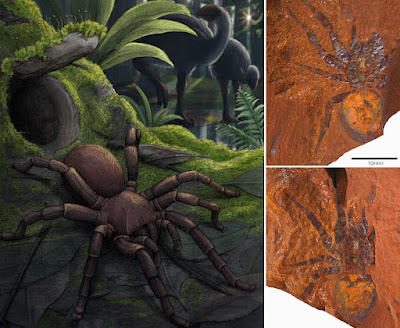Abstract
The aridification of the Australian continent led to the diversification of mygalomorph spiders in the Miocene, but a depauperate fossil record has made it difficult to investigate evolution across this epoch. Here, we describe the first fossil barychelid spider (Araneae: Barychelidae) in the world and the second fossil mygalomorph spider from Australia. It is placed as a new genus and species (Megamonodontium mccluskyi gen. et sp. nov.). Megamonodontium resembles Monodontium Kulczyński, 1908, a genus that persists in rainforests through Singapore, Indonesia and Papua New Guinea. The new specimen is the second largest spider fossil in the world and is approximately five times larger than extant Monodontium. The fossil shows that this lineage once occupied mesic rainforest habitats in Australia but has since been replaced by other spiders.
Keywords: Monodontium, Cenozoic, fossil, McGraths Flat, climate, arachnid, goethite
Systematic palaeontology
Order Araneae Clerck, 1757
Suborder Opisthothelae Pocock, 1892
Infraorder Mygalomorphae Pocock, 1892
Family Barychelidae Simon, 1889
Genus Megamonodontium gen. nov.
Diagnosis: Unlike most brush-footed trapdoor spiders, Megamonodontium has females with patella I shorter than tibia I (Fig. 1) and teeth on both the palpal claw (Fig. 3A, B) and the outer face of the paired tarsal claws of females. Megamonodontium differs from Tungari kenwayae Raven, 1994 in that the first leg is longer than the second and from all species of Zophorame in that its legs are robust, that it lacks well-developed scopulae, and that its head and abdomen are less slender. Megamonodontium differs from its putative sister genus, Monodontium, in having the carapace shape asymmetrical around the midpoint, with the widest point in the posterior third; Monodontium has the carapace asymmetrical around the midpoint (Raven 2008: fig. 8A, C); it is also about five times the size of known Monodontium (10 vs. 2 mm).
Locality: The holotype derives from McGraths Flat, a fossil site that is located ~25 km north-east of Gulgong, MSW, Australia. The fossil is preserved in a finely bedded goethite matrix with low levels of silica present, which has been dated to the Miocene (11–16 Mya), based on pollen and spores (McCurry et al. 2022).
Etymology: The genus name alludes to the nearest living relatives, tiny litter-dwelling brush-footed trapdoor spiders of the genus Monodontium.
Megamonodontium mccluskyi sp. nov.
Etymology: : The species is named after Simon McClusky, who found the specimen.
Matthew R. McCurry, Michael Frese and Robert Raven. 2023. A Large Brush-footed Trapdoor Spider (Mygalomorphae: Barychelidae) from the Miocene of Australia. Zoological Journal of the Linnean Society. zlad100, DOI: 10.1093/zoolinnean/zlad100




